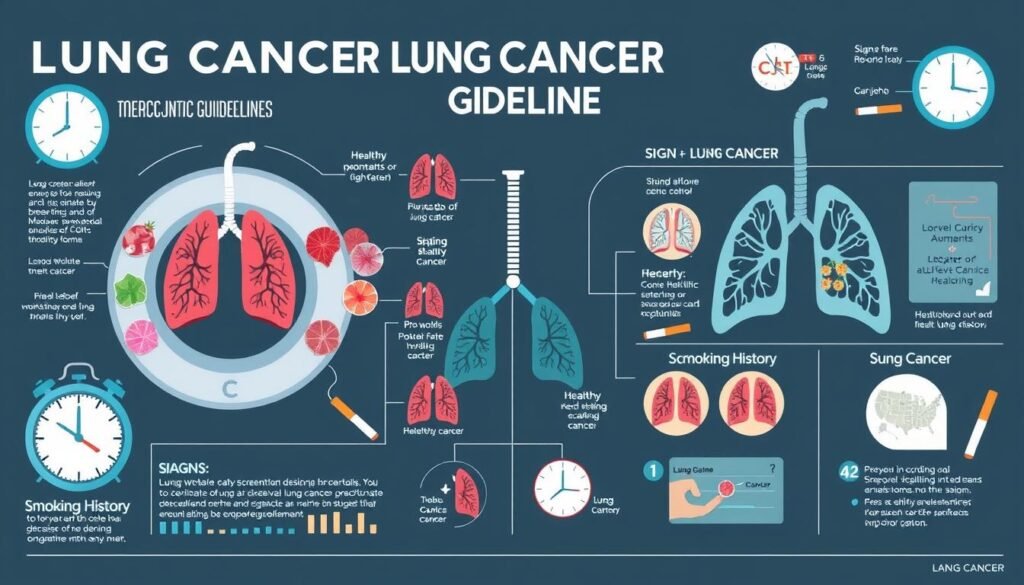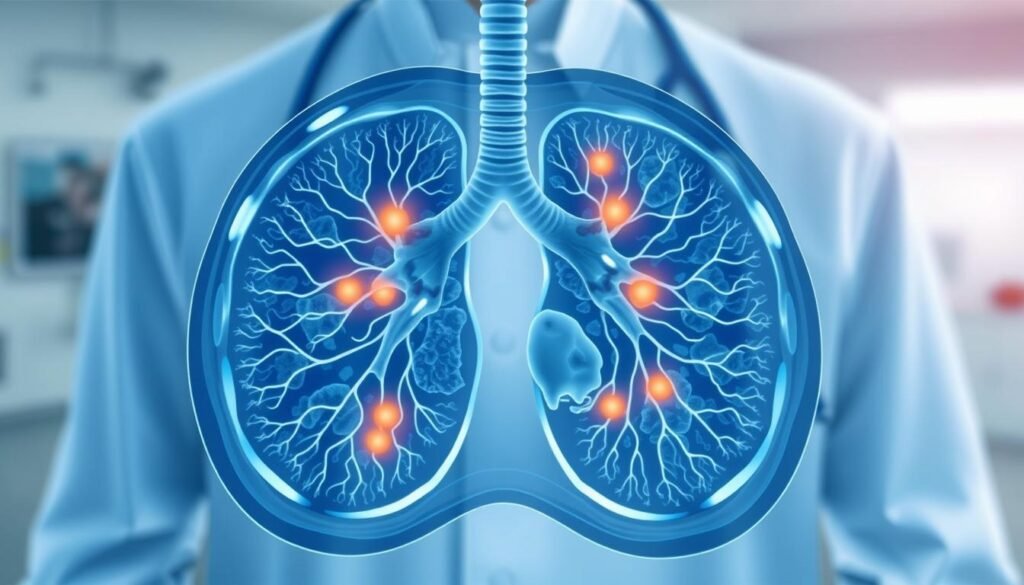Lung cancer leads in causing deaths due to cancer in both men and women in the U.S. Yet, many people don’t get screened early enough. The U.S. Preventive Services Task Force suggests yearly screens with low-dose CT for some people. This includes those who have smoked a lot over the years. Catching cancer early can save lives by improving survival rates.
Low-dose CT scans are not as harsh and expose people to less radiation. People aged 50 to 80, with a history of heavy smoking, should get checked every year. Knowing if you should get screened can help you take care of your health better. It allows people to be proactive in managing their well-being.
Key Takeaways
- Lung cancer screening is crucial for those at risk, particularly smokers aged 50 to 80.
- Low-dose CT scans are recommended over regular chest x-rays for effective screening.
- Many insurance plans, including Medicare, cover lung cancer screening costs.
- Yearly screenings can significantly improve the chances of successful treatment.
- Consultation for smoking cessation is important for higher-risk individuals.
Understanding Lung Cancer and Its Risks
Lung cancer is a major health issue in the United States. It is the second most common cancer among adults. Lung cancer is also the top reason for cancer-related deaths. More than 228,000 people were diagnosed in 2020, and over 135,000 died.
Smoking is the biggest cause of lung cancer, linked to about 90% of cases. Age is also important, especially for people over 50. Being around harmful things like asbestos and pollution adds to the risk. So does having a family history of lung cancer.
Knowing these risks is vital. It helps find lung cancer early in people who are more likely to get it. Catching it early means treatment might work better.
Using lung cancer facts in education programs can make a big difference. It helps fix wrong ideas and teaches about the risks. This encourages people to get checked early for signs of lung cancer.
Why Early Detection is Crucial for Lung Cancer
Early detection of lung cancer changes how it can be treated, improving lung cancer prognosis. Sadly, only 21% of lung cancers are found at stage I. It’s vital to screen early, boosting chances of survival.
People aged 50 to 80 who smoked a lot should get yearly screenings. The Centers for Medicare & Medicaid Services pays for these, thanks to US Preventive Services Task Force rules. Thanks to low-dose CT scans, we see a 20% lower death rate from lung cancer compared to chest X-rays.
The National Lung Screening Trial found most cancers early using these scans. Just a few were advanced. This shows how low-dose CTs can really help find lung cancer early and improve chances against it.
Yet, only 5.8% of those who could get screened do it. We need to make more people aware and work together. By doing so, we can catch more cancers early and save lives.
Eligibility Criteria for Lung Cancer Screening
Lung screening programs aim to identify individuals at high risk for lung cancer. People between 50 to 80 years old with a significant smoking history are considered high risk. Specifically, if you’ve smoked at least 20 pack-years, you’re advised to get yearly low-dose computed tomograpghy (LDCT) screenings. Screening during this age range is vital since early detection can greatly improve survival rates.
Not just current smokers are at risk, but also those who quit in the last 15 years. It’s worth noting that the risk of lung cancer remains elevated for former smokers even after this time. Their risks decrease slowly over time. Looking into making more people eligible for screening—like those who quit over 15 years ago—could greatly lower lung cancer deaths.
It’s important for potential candidates to understand these criteria well. Screening is suitable unless they have severe health issues reducing their life expectancy. Talking with healthcare providers about the lung cancer screening guidelines is key to making smart choices.
Using low-dose CT scans for screening has many benefits over risks from radiation exposure. This supports the reason for regular screenings for those who qualify. Good communication with doctors can boost knowledge and help people get these important screenings.
CT Scan for Lung Cancer Screening
A low-dose CT scan is key for checking lungs for cancer early. It uses advanced methods to spot risks early, which helps patients a lot.
What is a Low-Dose CT Scan?
A low-dose CT scan uses less radiation than regular scans. It takes many pictures of the lungs. These are put together to make detailed 3D models. This helps find signs of lung cancer early.
How Does a Low-Dose CT Scan Work?
Patients go through a quick scanning process. They lie on a table that moves through the scanner. It takes pictures from different angles.
This creates clear, high-quality images. These images help find lung cancer early. Catching it early improves chances of successful treatment.
The Benefits of Low-Dose CT Scans in Lung Cancer Detection
Low-dose CT scans are key in catching lung cancer early. They are especially good for those 50 to 80 who smoked a lot. Studies prove they can greatly reduce deaths from lung cancer. The NELSON trial saw a 33 percent drop in lung cancer deaths among women. For men, the decrease was 24 percent when screened versus those who weren’t.
These scans also help increase survival rates. The American Cancer Society believes they could prevent 60,000 deaths each year in the U.S. They emit only 1.4 millisieverts (mSv), much less than the 7 mSv from standard scans. This makes them a safer choice for regular use.
Moreover, low-dose CT scans allow doctors to check lungs more often. This helps catch changes early, leading to better chances of successful treatment. While there are risks like radiation and false positives, the benefits for those at high risk are significant.
In conclusion, the advantages of low-dose CT scans in early lung cancer detection are clear. For more details on this important test, visit this resource.
Lung Cancer Screening Guidelines
It’s important to know the newest guidelines for lung cancer screening. These guidelines help find the disease early in people at high risk. Catching lung cancer early can save lives.
Who Should Get Screened?
If you are between 50 and 77 years old and have smoked a lot, you should get screened. Smoking one pack a day for a year equals a pack-year. Even if you have quit in the last 15 years, it’s good to follow these rules.
Before your first screening, a special meeting to make a plan together is key. You can do this when you see your doctor for other reasons too.
Recommended Screening Intervals
An annual check-up is vital to catch any new changes. Your doctor will decide how often you need the LDCT screening based on your situation. Staying on track with screenings means problems can be found and treated early.

Understanding the Screening Process
The lung cancer screening starts with an in-depth first meeting. In this talk, doctors look at risk factors. These can be how long you’ve smoked or if your family has had lung diseases. They decide if the screening is right for you.
Next, patients who can have the screening get a CT scan. This scan is key in spotting lung cancer early. It’s quick, taking just a few minutes. You lie down, and the machine takes pictures all around. These images help catch lung cancer early, boosting your chance to beat it.
Getting ready for the CT scan is usually simple. There are hardly any rules to follow, making it stress-free. Knowing what happens next can ease worries. It helps patients feel better about their screening.
The LDCT scan’s findings are vital for understanding lung health. At first, there might be false alarms. But with more scans, these mistakes happen less often. So, it’s key to keep checking. Knowing all this pushes people to care for their lung health early on.
What to Expect After Your CT Scan
After a CT scan for lung cancer screening, you can expect a clear process. You’ll understand your results step by step. Results are often called positive, negative, or indeterminate, which leads to different next steps.
Interpreting Results: Positive, Negative, and Indeterminate Results
A positive result means someone saw something unusual. This could mean more tests or a biopsy are needed. About 16% of people with positive CT scans are diagnosed with lung cancer. Getting follow-up care quickly is important if your results are positive.
Seeing no problems on the scan means your result is negative, which is great news for your lung health. But sometimes, results aren’t clear. This is called indeterminate. You might need more scans to understand what’s really going on.
Talking to your doctors about your results is key. Usually, you’ll get your results in a letter within two weeks. If there’s more to discuss, your care team will get in touch to chat about next steps.

Only about 10% to 15% of people who could get lung cancer screening actually do. It’s a huge missed chance for staying healthy. Annual screenings could lower lung cancer deaths by 20% to 26%. Learning about the screening process is crucial.
If you want to know more about what to expect after your scan, talk to your doctor. You can also look at these guidelines from health experts here.
Insurance and Cost Considerations for Lung Cancer Screening
Knowing about lung cancer screening costs and insurance helps patients decide on screening. Most health insurance plans, including Medicare, often pay for low-dose CT scans for lung cancer. But, coverage details might differ, so it’s wise to check your plan first.
Medicare covers lung cancer screening for those 50 to 77 years old with a history of 20 pack-years of smoking. These individuals don’t have to pay copays, coinsurance, or deductibles for screening. Plus, Medicare provides yearly screenings to keep at-risk patients covered without extra costs.
Medicaid expansion covers screenings for those making up to 138% of the Federal Poverty Level, even if they don’t have kids. There’s usually no cost-sharing for those aged 50 to 80. Yet, each state’s Medicaid might have its own rules, so it’s important to check.
Private Health Insurance coverage for lung cancer screening might be different. Many plans for workers cover people aged 50 to 80 who’ve smoked 20 pack-years, without extra costs. However, checking your plan is key as there could be out-of-pocket expenses for extra tests after an abnormal result.
Even without insurance, there are local agencies that help by offering screenings at lower prices or for free. Understanding these options helps patients make smart health choices, getting screenings without too much financial worry.
Support for Smokers: Resources and Quitting Strategies
Quitting smoking is the best way to lower the risk of lung cancer. There are many resources to help people stop smoking. These include counseling, support groups, and online programs made to help quit smoking.
Learning about the risks of lung cancer and quitting benefits is key. This knowledge can drive smokers to find help. Joining a structured program often leads to a successful quit. A study showed that combining a quit smoking program with lung cancer screening reduced lung cancer deaths by 14%.
The American Lung Association offers a lot of help for those wanting to quit. They focus on working together with doctors to support quitting. This approach creates a helpful environment for those trying to stop smoking.
It’s critical to focus on those at high risk. Doctors working together to offer quit smoking resources can really help. These resources are important for groups hit harder by lung cancer and smoking.

| Resource Type | Description | Examples |
|---|---|---|
| Counseling | Personalized support from trained professionals | Individual therapy, group sessions |
| Support Groups | Peer-led or professional-led gatherings to encourage quitting | Local community groups, online forums |
| Online Programs | Web-based resources providing tools for quitting | Stop smoking apps, video guides |
Having access to these resources makes quitting smoking much more likely. Putting effort into stopping smoking leads to better health and less lung cancer.
For more detailed info about quitting smoking and fighting lung cancer, check out this research and effective strategies.
Conclusion
Lung cancer screening with low-dose CT scans is a major step forward. It is crucial for people at high risk. Studies prove it finds lung cancer early. This increases survival rates greatly.
For those who smoked before, getting screened could save your life. It’s really important.
It’s wise to talk to health experts about lung screening. They can help you understand if it’s right for you. You can make smart choices about your health with the right info.
Screening for lung cancer is super important. It helps find the disease early. And, it teaches us more about lung cancer.
To learn more about these screenings, check out this article on lung cancer screening.